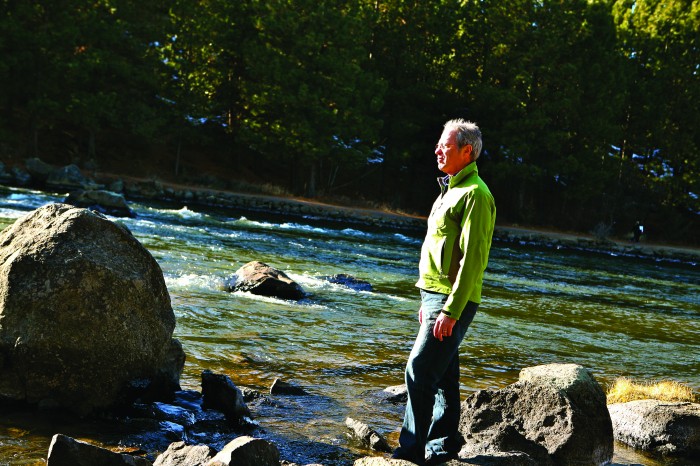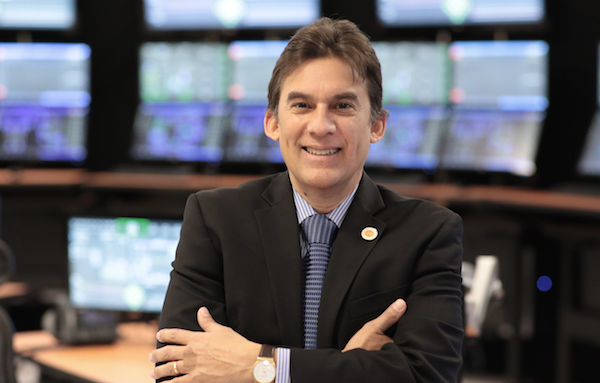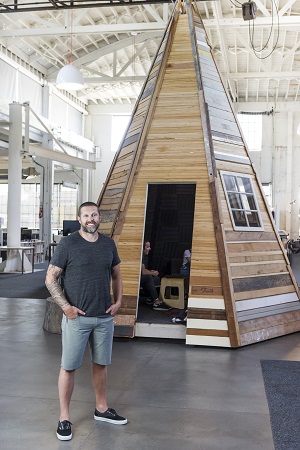The Deschutes River flowed icy blue under an arching footbridge at Sawyer Park in Bend. On the right side of the river, ancient layers of rock glowed orange at dusk, and joggers and mountain bikers caught the last light of a chilly January day on the east flank of the Cascades.
Half a mile up river, three hulking irrigation pipes are set to reopen in April to drain a good portion of this in-stream flow and send it out to the agricultural fields of the high desert—to farms in Terrebonne and as far away as Culver. This section of the Deschutes River becomes a shallow, rocky concourse.
Tod Heisler stands on the opposite side of the bridge, watching some of the most controversial water in Oregon splash its way downstream, where it will hit three dams before meeting the Columbia. He is the executive director of the Deschutes River Conservancy (DRC), the organization whose mission is to restore flows and water quality to all rivers and tributaries in the Deschutes Basin. Before 2008, nearly half of DRC’s funding came from federal sources, a third from the state and the remainder from foundations and corporations. In recent years, the federal funding portion has all but disappeared.
Heisler is quick to laugh, and just as quick to speak with gravity about what can be achieved through cooperation. “In the old days, this section used to dry up in certain years,” Heisler says, gesturing over the bridge. “Then, in the ’60s, the irrigation districts said, ‘It’s really not a good idea to dry up a river. We’ll leave thirty cubic feet per second.’ In fifteen years, working cooperatively with these same districts, we’ve taken flows from thirty to 150, a fivefold increase in a very short amount of time.”
That additional water is the equivalent of six Olympic-sized swimming pools pouring into the Deschutes and its tributaries every hour, according to the DRC’s calculations.
The working model of the DRC, a consensus- and incentive-based forum where all competing interests have a vote, was progressive for its time in the ’90s. It is now a model across the nation as a voluntary, non-regulatory approach to resolving natural resource issues. Stakeholders, with interests as polarized as ranching and environmental protection, must come to the table every month and make cooperative decisions.
“Historically, environmental and natural resource-based problems were solved through litigation and regulation,” notes Heisler. “Everyone hires a lawyer, goes to court and tries to maximize their own benefit. Here, we ask a different question. And that is ‘What can we do together to optimize benefits for everyone who has an interest in the watershed?’”
When Heisler arrived at the DRC in 2004, after twenty-two years of leading such organizations in Washington, D.C. as the World Wildlife Federation and Conservation International, he used his experience to deflect the organization from experimenting and move toward its own proven models for flow restoration.
One thing everyone at the table could agree on was that the geography of Central Oregon created an extremely inefficient foundation for ditch-fed irrigation. More than half the water diverted from rivers and streams was lost in the porous bones of ancient lava flows.
As the board’s collaborative efforts permanently restored flows through piping and lining projects—as well as complex agreements involving water leasing and transfers—Heisler set the stage for a much loftier and ambitious goal: restoring steelhead and salmon runs on the Deschutes.
In order for anadromous fish to thrive within the river’s ecosystem, restoration efforts would need to expand to an unprecedented scale.
The first task was bringing together like-minded conservationists, then creating a massive cooperative strategy and timeline. The Deschutes Land Trust, Upper Deschutes Watershed Council and the Crooked River Irrigation District came to the table under Heisler’s leadership at the DRC and became the Deschutes Special Investment Partnership. Together, they helped devise a plan that would win the group millions of dollars from the Oregon Watershed Enhancement Board (OWEB), a state agency funded by the Oregon Lottery, federal dollars, the salmon license plate revenue and the Pelton Fund—two grant makers that were impressed with this group’s strategy. That marked the first time in the Watershed Enhancement Board’s thirteen-year history it had funded a strategic plan rather than a single project.
“This is a very different approach than, ‘Let’s write a proposal for a fish habitat over here and a stream-flow restoration over there,’” Heisler acknowledges. “Using that system, our goals for the watershed would take centuries to achieve. When you work as a team, you can coordinate all the parts, and when you do them sequentially, all in one place, you have watershed impact. Now you have changed the very nature, character and functionality of a river or creek.”
Under this aegis of cooperation, Heisler has been successful in completing many critical projects while more are in the works. One opus underway is the largest water conservation project in Oregon’s history on the Crooked River. This aims to restore 220 CFS to the river above Smith Rock State Park, and permanently improve ecosystems and fish habitat.
“A lot of people have asked me how I could go from having this glamorous job in D.C. to working closer to the ground like this, and I tell them that I couldn’t be happier,” Heisler reflects. “I can use my strengths as a strategist, and then come down here and see and feel the results of our hard work.”
Deschutes River Conservancy Milestones
2003
– DRC is approved as the first state-chartered groundwater mitigation bank.
2004
– Tod Heisler becomes the DRC’s new executive director.
– The Deschutes Water Alliance is formed.
– The Pelton Fund is created.
2005
– Heisler works with partners to form the Deschutes Partnership.
2007
– Chinook and steelhead fry are reintroduced to the Deschutes River.
– The DRC receives the Department of Interior’s Cooperative Conservation Award for its progress using the consensus-based model.
2008
– The national economic downturn saps federal funding from the DRC.
– The Oregon Watershed Enhancement Board (OWEB) allocates $4 million to the Deschutes Partnership. The partners won the grant by presenting an integrated strategy to re-establish anadromous fish runs and enhance resident fish populations throughout the Deschutes River Basin.
2009
– A multiyear project in Sisters launches to re-flow Whychus Creek through its historic channel at Camp Polk, providing spawning and rearing habitat for native and migrating fish.
– OWEB awards an additional $4 million to Deschutes Partnership.
– Fish passage is achieved at the Pelton Round Butte dams.
2010
– The Deschutes Water Alliance reforms and expands to develop a regional water management plan for the basin.
2011
– The largest water conservation initiative in Oregon’s history is underway on the Crooked River to restore up to 220 CFS of stream flow to the Crooked River where it runs through Smith Rock State Park.
– The first adult Chinook and steelhead find their way back up the Deschutes from the Pacific Ocean after first being introduced in 2007.
Contribute
MAY 11 | TIGHT LINES AUCTION AND BBQ
Food, drink and fishing stories come together with art for an evening at Shevlin Hall in Bend. 5:30-10 p.m., $50
RIVERFEAST AT RANCH AT THE CANYONS
Food, drink and music at the inspiring Ranch at the Canyons across the Crooked River from Smith Rock. $175 per couple. Date TBA.
541.382.4077 | deschutesriver.org










I am sure that his story of success will help many people to find their own way